中西文化差异情景案例分析说课讲解
- 格式:doc
- 大小:124.50 KB
- 文档页数:28
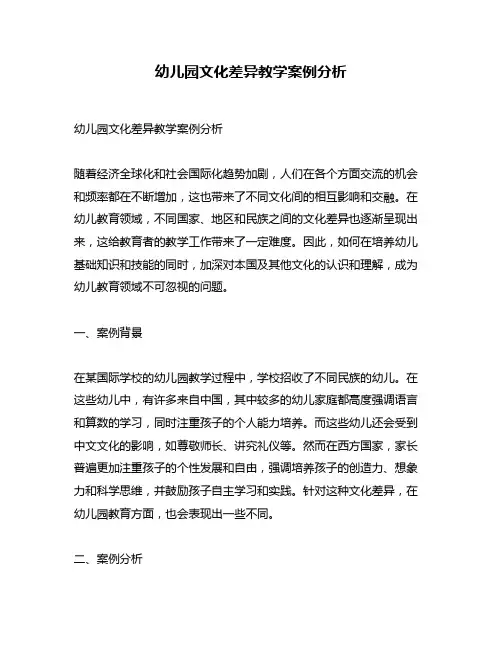
幼儿园文化差异教学案例分析幼儿园文化差异教学案例分析随着经济全球化和社会国际化趋势加剧,人们在各个方面交流的机会和频率都在不断增加,这也带来了不同文化间的相互影响和交融。
在幼儿教育领域,不同国家、地区和民族之间的文化差异也逐渐呈现出来,这给教育者的教学工作带来了一定难度。
因此,如何在培养幼儿基础知识和技能的同时,加深对本国及其他文化的认识和理解,成为幼儿教育领域不可忽视的问题。
一、案例背景在某国际学校的幼儿园教学过程中,学校招收了不同民族的幼儿。
在这些幼儿中,有许多来自中国,其中较多的幼儿家庭都高度强调语言和算数的学习,同时注重孩子的个人能力培养。
而这些幼儿还会受到中文文化的影响,如尊敬师长、讲究礼仪等。
然而在西方国家,家长普遍更加注重孩子的个性发展和自由,强调培养孩子的创造力、想象力和科学思维,并鼓励孩子自主学习和实践。
针对这种文化差异,在幼儿园教育方面,也会表现出一些不同。
二、案例分析在这种文化差异的背景下,教师们需要掌握的不仅是幼儿的具体表现,还必须理解背后的文化和情境因素,从而制定相应的教学策略与方法。
下面以某个具体的教学案例为例加以分析。
教学案例:幼儿绘画活动某学校举办了一次绘画比赛,要求幼儿自由发挥、完成一幅自己最喜欢的主题的绘画作品。
中国幼儿家长的思维方式,在孩子实际发挥之前,就会规定出一定的目标和结果。
且在绘画的时候会很严格地要求孩子不能乱放颜色,不可以超出画布等,甚至可能会对孩子的画作进行雕琢。
而西方文化中则完全不同,更关注孩子自由发挥,不一定规定目标和结果,鼓励孩子放松、激发创造力,因此孩子的绘画也更具有自由和创造性。
如何解决这种文化差异呢?教师要从幼儿的角度出发,尊重幼儿的自主性和主体性,设法让幼儿感到更尊重、平等、自由的情境。
教师可以通过以下措施来协助幼儿完成绘画作品:1.给幼儿提供自由环境,鼓励幼儿自由发挥;2.进行自然的引导,指导孩子如何使用绘画材料;3.提供话语支持和视觉支持,让幼儿能够理解比赛规则,获得成就感;4.教师要给予幼儿受认可和鼓励,让幼儿感到被重视和被依靠。
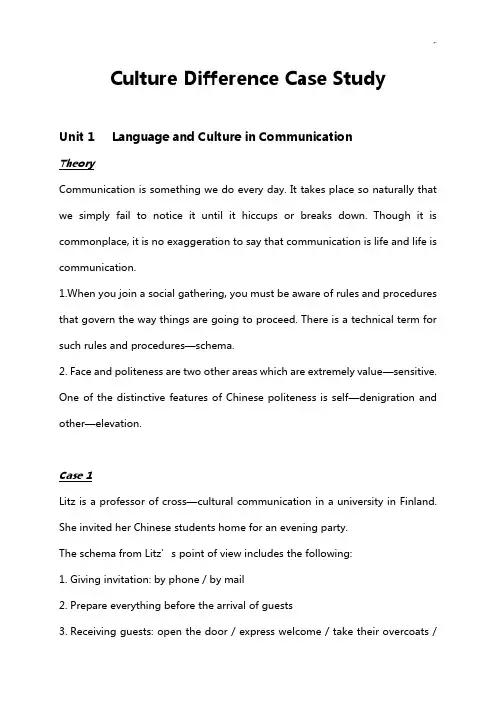
Culture Difference Case StudyUnit 1 Language and Culture in CommunicationTheoryCommunication is something we do every day. It takes place so naturally that we simply fail to notice it until it hiccups or breaks down. Though it is commonplace, it is no exaggeration to say that communication is life and life is communication.1.When you join a social gathering, you must be aware of rules and procedures that govern the way things are going to proceed. There is a technical term for such rules and procedures—schema.2. Face and politeness are two other areas which are extremely value—sensitive. One of the distinctive features of Chinese politeness is self—denigration and other—elevation.Case 1Litz is a professor of cross—cultural communication in a university in Finland. She invited her Chinese students home for an evening party.The schema from Litz’s point of view includes the following:1. Giving invitation: by phone / by mail2. Prepare everything before the arrival of guests3. Receiving guests: open the door / express welcome / take their overcoats /introduce guests / offer them drinks / make them comfortable4. Serving food: set the table / soup first / main course / desert5. Post dinner activities: chat / play music / offer more drinks6. Seeing guests off: thank them for coming / good nightLitz’s evening party was not very successful, because she was upset by one of her guests. Here was the initial conversation between Litz and Lin:Litz: (opens the door) Oh, Lin, how nice you could come!Lin: It’s not difficult to find your house.Litz: Come on in.Lin: (comes in)Litz: Can I take your coat?Lin: No, thanks.Litz: Ok, this way please.Lin: (take off her coat and hangs it)Analysis: Litz was hurt because Lin did not let her hang her coat. Litz’s offering to hang Lin’s coat is one of Litz’s ways (it’s on Litz’s schema). On Lin’s side, she thought that Litz was her supervisor and that it was inappropriate to let her supervisor hang her coat. Here we have an instance of one action attached with different cultural values.Case 2Finding an Interested BuyerGeorage Hall was in Beijing attending a trade fair and looking for an opportunity to do business in China. He had been very successful in his business dealings in the US and prided himself on his ability “to get things moving.”His first day was going well .He looked around at the displays of sporting equipment to get some idea of whom he might approach. He was sure that his products, tennis rackets with an unusual new design, would arouse some interests. On the second day he approached the company which he felt would be most responsive to his products. He introduced himself to the general, a Mr. Li. Since he had read that Chinese find getting down to business immediately too abrupt and rude, he began a casual conversation, eventually leading up to the topic of his products and suggesting how Mr. Li’s company might benefit from using them. George then suggested that he could arrange to get together with Mr. Li and provide more specifics and documentation on his products.Mr. Li responded in fairly good English,”That would be interesting.”Knowing that he had only a few days left in Beijing, George wanted to nail down a time,”When can we meet?”asked George.“Ah. This week is very busy,”replied Mr. Li.“It sure is,”said George,”How about 10 o’clock? Meet you here.”“Tomorrow at 10 o’clock?”asked Mr. Li thoughtfully.“Right,”said George, “I’ll see you then?”“Hmm, yes; why don’t you come by tomorrow,”was the reply.“OK,”responded George,”It was nice meeting you.”The next day at 10 o’clock he approached Mr. Li’s company’s exhibit only to find that Mr. Li had some important business and was not able to meet with George. He called back later in the day and was told that Mr. Li was not available.Analysis:英美人士做事情讲究守时。
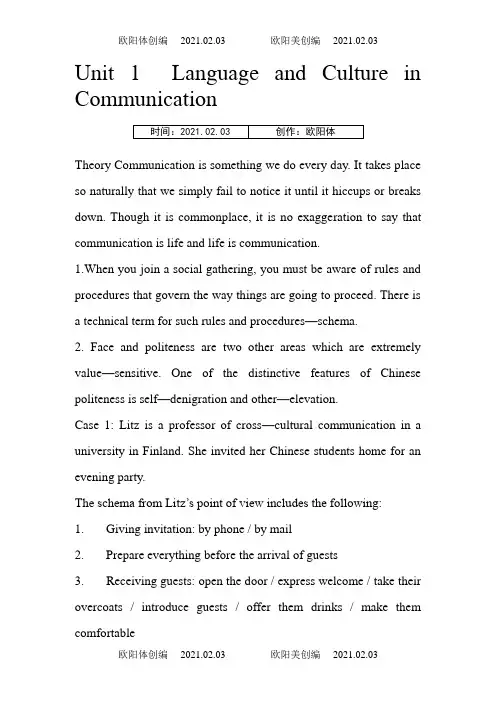
Unit 1 Language and Culture in CommunicationTheory Communication is something we do every day. It takes place so naturally that we simply fail to notice it until it hiccups or breaks down. Though it is commonplace, it is no exaggeration to say that communication is life and life is communication.1.When you join a social gathering, you must be aware of rules and procedures that govern the way things are going to proceed. There isa technical term for such rules and procedures—schema.2. Face and politeness are two other areas which are extremely value—sensitive. One of the distinctive features of Chinese politeness is self—denigration and other—elevation.Case 1: Litz is a professor of cross—cultural communication in a university in Finland. She invited her Chinese students home for an evening party.The schema from Litz’s point of view includes the following:1. Giving invitation: by phone / by mail2. Prepare everything before the arrival of guests3. Receiving guests: open the door / express welcome / take their overcoats / introduce guests / offer them drinks / make them comfortable4. Serving food: set the table / soup first / main course / desert5. Post dinner activities: chat / play music / offer more drinks6. Seeing guests off: thank them for coming / good nightLitz’s evening party was not very successful, because she was upset by one of her guests. Here was the initial conversation between Litz and Lin:Litz: (opens the door) Oh, Lin, how nice you could come!Lin: It’s not difficult to find your house.Litz: Come on in.Lin: (comes in)Litz: Can I take your coat?Lin: No, thanks.Litz: Ok, this way please.Lin: (take off her coat and hangs it)Analysis: Litz was hurt because Lin did not let her hang her coat. Litz’s offering to hang Lin’s coat is one of Litz’s ways (it’s on Litz’s schema). On Lin’s side, she thought that Litz was her supervisor and that it was inappropriate to let her supervisor hang her coat. Here we have an instance of one action attached with different cultural values. Case 2:Finding an Interested BuyerGeorage Hall was in Beijing attending a trade fair and looking for anopportunity to do business in China. He had been very successful in his business dealings in the U S and prided himself on his ability “to get things moving.” His first day was going well .He looked around at the displays of sporting equipment to get some idea of whom he might approach. He was sure that his products, tennis rackets with an unusual new design, would arouse some interests. On the second day he approached the company which he felt would be most responsive to his products. He introduced himself to the general, a Mr. Li. Since he had read that Chinese find getting down to business immediately too abrupt and rude, he began a casual conversation, eventually leading up to the topic of his products and suggesting how Mr. Li’s company might benefit from using them. George then suggested that he could arrange to get together with Mr. Li and provide more specifics and documentation on his products.Mr. Li responded in fairly good English,” That would be interesting.”Knowing that he had only a few days left in Beijing, George wanted to nail down a time,” When can we meet?” asked George.“Ah.This week is very busy,” replied Mr. Li.“It sure is,” said George,” How about 10 o’clock? Meet you here.”“Tomorrow at 10 o’clock?” asked Mr. Li thoughtfully.“Right,” said George, “I’ll see you then?”“Hmm, yes; why don’t you come by tomorrow,” was the reply.“OK,” responded George,” It was nice meeting you.”The next day at 10 o’clock he approached Mr. Li’s company’s exhibit only to find that Mr. Li had some important business and was not able to meet with George. He called back later in the day and was told that Mr. Li was not available.Analysis: 英美人士做事情讲究守时。
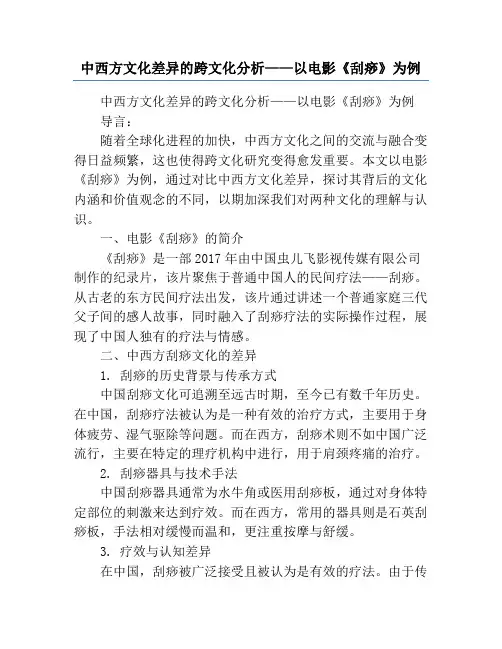
中西方文化差异的跨文化分析——以电影《刮痧》为例中西方文化差异的跨文化分析——以电影《刮痧》为例导言:随着全球化进程的加快,中西方文化之间的交流与融合变得日益频繁,这也使得跨文化研究变得愈发重要。
本文以电影《刮痧》为例,通过对比中西方文化差异,探讨其背后的文化内涵和价值观念的不同,以期加深我们对两种文化的理解与认识。
一、电影《刮痧》的简介《刮痧》是一部2017年由中国虫儿飞影视传媒有限公司制作的纪录片,该片聚焦于普通中国人的民间疗法——刮痧。
从古老的东方民间疗法出发,该片通过讲述一个普通家庭三代父子间的感人故事,同时融入了刮痧疗法的实际操作过程,展现了中国人独有的疗法与情感。
二、中西方刮痧文化的差异1. 刮痧的历史背景与传承方式中国刮痧文化可追溯至远古时期,至今已有数千年历史。
在中国,刮痧疗法被认为是一种有效的治疗方式,主要用于身体疲劳、湿气驱除等问题。
而在西方,刮痧术则不如中国广泛流行,主要在特定的理疗机构中进行,用于肩颈疼痛的治疗。
2. 刮痧器具与技术手法中国刮痧器具通常为水牛角或医用刮痧板,通过对身体特定部位的刺激来达到疗效。
而在西方,常用的器具则是石英刮痧板,手法相对缓慢而温和,更注重按摩与舒缓。
3. 疗效与认知差异在中国,刮痧被广泛接受且被认为是有效的疗法。
由于传统医学的影响,许多中国人对刮痧的疗效深信不疑,并且将其视为文化传统的一部分。
而在西方,刮痧疗法仍被一些人视为神秘的、不科学的治疗方式,其疗效与安全性受到质疑。
三、中西方文化背后的差异1. 身体观念的不同中西方文化在身体观念上存在明显的差异。
在中国文化中,人们经常强调“身心合一”的观念,注重身体与自然之间的和谐关系。
而在西方,科学和医学方面的发展更多关注身体的理性和可测量性。
2. 传统与现代思维的碰撞中西方文化差异也体现在人们对于传统与现代思维之间的态度上。
中国社会普遍保留着对传统文化的尊重和传承,因此在对待刮痧疗法时更容易接受。

中西文化差异总结中西文化差异以及对近代中国的影响在中国两千多年的封建社会历史的过程中,儒家思想一直占据着根深蒂固的弦统治地位,对中国社会产生了极其深刻而久远的影响。
中国人向来以自我贬仰的思想作为处世经典,这便是以儒家的“中庸之道”作为行为的基本准则。
“中”是儒家追求的理想境界,人生处世要以儒家仁、义、礼、智、信的思想道德观念作为每个人的行为指南,接人待物,举止言谈要考虑温、良、恭、俭、让,以谦虚为荣,以虚心为本,反对过分地显露自己表现自我。
因此,中国文化体现出群体性的文化特征,这种群体性的文化特征是不允许把个人价值凌驾于群体利益之上的。
西方国家价值观的形成至少可追溯到文艺复兴运动。
文艺复兴的指导思想是人文主义,即以崇尚个人为中心,宣扬个人主义至上,竭力发展自己表现自我。
“谦虚”这一概念在西方文化中的价值是忽略不计的。
生活中人们崇拜的是“强者”“英雄”。
有本事,有才能的强者得到重用,缺乏自信的弱者只能落伍或被无情地淘汰。
因此,西方文化体现出个体文化特征,这种个体性文化特征崇尚个人价值凌驾于群体利益之上。
中西方文化的发展态势不同。
中国文化中整体上来看,属于一种静态文化、一种家国文化。
由于中国所处地理环境较为优越,给予了人一个可以长期居住生产的环境,所以,这种长期居住在同一个地方的条件便使家族发展的很快,安居乐业、居安而不思流动,就容易促使静态的文化模式发展。
家族繁衍、代代相传,家族纽带越来越复杂,尊老和祭祖现象就必然在这样的发展模式下产生,家族观念,宗法制度也就逐渐形成并根深蒂固了。
所以说,中国为什么叫家国,因为,家就是国、国就是家,家和国仅仅是规模上的差别,于此,这种静态文化和家国文化直接促成了中国仁、孝、礼、信为核心的贵和尚中的中庸思想。
而西方文化则属于一种动态文化、一种斗争文化。
西方文化三大起源(古希腊文明、罗马文明和基督教文明)均源自地中海沿岸,西方的地理环境、气候促成了流动性较强的文化。
并直接促使西方人的家庭观念相对薄弱,个人主义、自由主义等价值观念得以发展传承,由此产生的竞争意识、斗争文化更是西方文化发展的原动力。
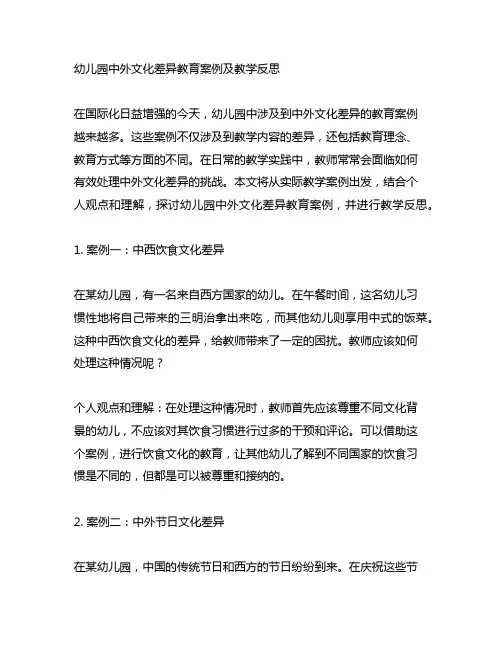
幼儿园中外文化差异教育案例及教学反思在国际化日益增强的今天,幼儿园中涉及到中外文化差异的教育案例越来越多。
这些案例不仅涉及到教学内容的差异,还包括教育理念、教育方式等方面的不同。
在日常的教学实践中,教师常常会面临如何有效处理中外文化差异的挑战。
本文将从实际教学案例出发,结合个人观点和理解,探讨幼儿园中外文化差异教育案例,并进行教学反思。
1. 案例一:中西饮食文化差异在某幼儿园,有一名来自西方国家的幼儿。
在午餐时间,这名幼儿习惯性地将自己带来的三明治拿出来吃,而其他幼儿则享用中式的饭菜。
这种中西饮食文化的差异,给教师带来了一定的困扰。
教师应该如何处理这种情况呢?个人观点和理解:在处理这种情况时,教师首先应该尊重不同文化背景的幼儿,不应该对其饮食习惯进行过多的干预和评论。
可以借助这个案例,进行饮食文化的教育,让其他幼儿了解到不同国家的饮食习惯是不同的,但都是可以被尊重和接纳的。
2. 案例二:中外节日文化差异在某幼儿园,中国的传统节日和西方的节日纷纷到来。
在庆祝这些节日的活动中,教师发现一些外籍幼儿对中国传统节日缺乏了解,而中国幼儿对西方节日也不甚了解。
这种中外节日文化的差异如何处理呢?个人观点和理解:教师应该充分利用这些节日活动,向幼儿传授不同文化的知识,让他们在享受活动的能够了解和尊重不同国家的传统节日。
可以通过制作手工、讲故事等方式,让幼儿在游戏中学习,增强其对中外文化的理解和包容性。
3. 案例三:中外教育方式差异在某国际幼儿园,中外教师的合作成为了一个亮点。
中方教师注重传统的教育方式,强调学生的听从和服从;而外籍教师更倾向于启发式的教学方式,注重培养学生的创造力和想象力。
这种中外教育方式的差异如何协调和融合呢?个人观点和理解:教师之间可以开展磨合期的交流和合作,相互学习对方的优点和特色,逐渐形成共识和共同的教育理念。
在教学实践中,可以根据幼儿的特点和需求,采取灵活多样的教学方式,即传统的条理性教学与启发式的激发学生兴趣相结合,让教育方式更富有包容性和创造性。
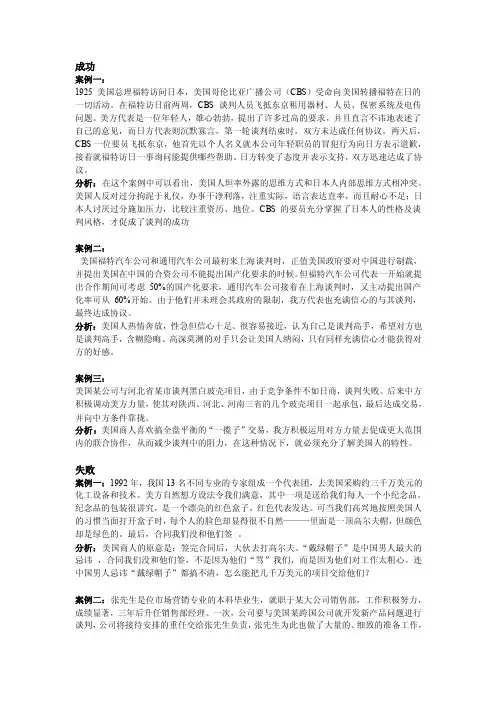
成功案例一:1925美国总理福特访问日本,美国哥伦比亚广播公司(CBS)受命向美国转播福特在日的一切活动。
在福特访日前两周,CBS谈判人员飞抵东京租用器材、人员、保密系统及电传问题。
美方代表是一位年轻人,雄心勃勃,提出了许多过高的要求,并且直言不讳地表述了自己的意见,而日方代表则沉默寡言,第一轮谈判结束时,双方未达成任何协议。
两天后,CBS一位要员飞抵东京,他首先以个人名义就本公司年轻职员的冒犯行为向日方表示道歉,接着就福特访日一事询问能提供哪些帮助。
日方转变了态度并表示支持,双方迅速达成了协议。
分析:在这个案例中可以看出,美国人坦率外露的思维方式和日本人内部思维方式相冲突。
美国人反对过分拘泥于礼仪,办事干净利落,注重实际,语言表达直率,而且耐心不足;日本人讨厌过分施加压力,比较注重资历、地位。
CBS的要员充分掌握了日本人的性格及谈判风格,才促成了谈判的成功案例二:美国福特汽车公司和通用汽车公司最初来上海谈判时,正值美国政府要对中国进行制裁,并提出美国在中国的合资公司不能提出国产化要求的时候。
但福特汽车公司代表一开始就提出合作期间可考虑50%的国产化要求,通用汽车公司接着在上海谈判时,又主动提出国产化率可从60%开始。
由于他们并未理会其政府的限制,我方代表也充满信心的与其谈判,最终达成协议。
分析:美国人热情奔放,性急但信心十足、很容易接近,认为自己是谈判高手,希望对方也是谈判高手,含糊隐晦、高深莫测的对手只会让美国人纳闷,只有同样充满信心才能获得对方的好感。
案例三:美国某公司与河北省某市谈判黑白玻壳项目,由于竞争条件不如日商,谈判失败。
后来中方积极调动美方力量,使其对陕西、河北、河南三省的几个玻壳项目一起承包,最后达成交易,并向中方条件靠拢。
分析:美国商人喜欢搞全盘平衡的“一揽子”交易,我方积极运用对方力量去促成更大范围内的联合协作,从而减少谈判中的阻力,在这种情况下,就必须充分了解美国人的特性。
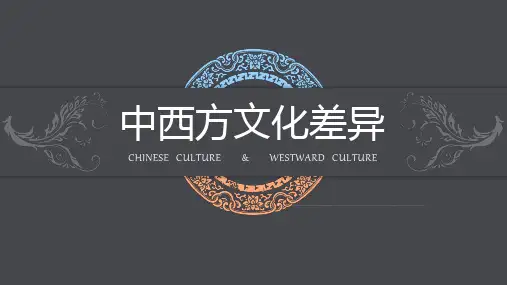
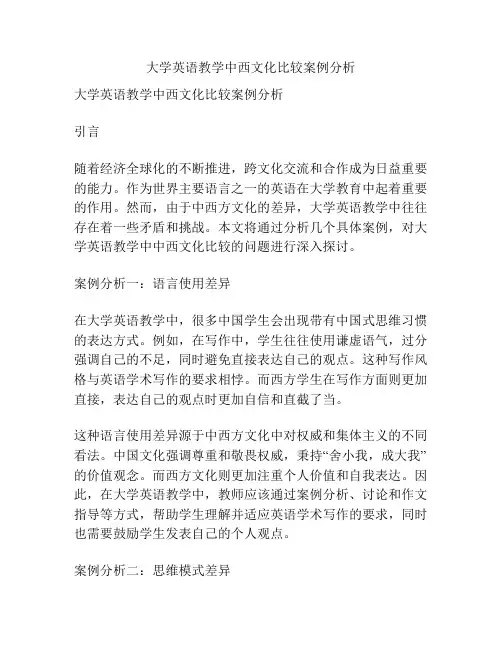
大学英语教学中西文化比较案例分析大学英语教学中西文化比较案例分析引言随着经济全球化的不断推进,跨文化交流和合作成为日益重要的能力。
作为世界主要语言之一的英语在大学教育中起着重要的作用。
然而,由于中西方文化的差异,大学英语教学中往往存在着一些矛盾和挑战。
本文将通过分析几个具体案例,对大学英语教学中中西文化比较的问题进行深入探讨。
案例分析一:语言使用差异在大学英语教学中,很多中国学生会出现带有中国式思维习惯的表达方式。
例如,在写作中,学生往往使用谦虚语气,过分强调自己的不足,同时避免直接表达自己的观点。
这种写作风格与英语学术写作的要求相悖。
而西方学生在写作方面则更加直接,表达自己的观点时更加自信和直截了当。
这种语言使用差异源于中西方文化中对权威和集体主义的不同看法。
中国文化强调尊重和敬畏权威,秉持“舍小我,成大我”的价值观念。
而西方文化则更加注重个人价值和自我表达。
因此,在大学英语教学中,教师应该通过案例分析、讨论和作文指导等方式,帮助学生理解并适应英语学术写作的要求,同时也需要鼓励学生发表自己的个人观点。
案例分析二:思维模式差异除了语言使用差异外,中西方文化在思维模式方面也存在差异。
中文学术思考更多倾向于归纳法和比喻法,注重整体性思考。
而西方学术思维则更加注重分析法和抽象法,强调逻辑和系统性思考。
在大学英语教学中,这种思维模式差异常常表现在阅读理解和写作中。
中国学生倾向于追求“宏观感悟”,而西方学生注重“微观事实”。
这导致了中西方学生在阅读理解过程中对重点和细节的把握存在差异,也影响了写作的逻辑性和清晰度。
针对这个问题,教师可以通过引入英文原著、讨论经典案例和进行小组合作等方式,帮助学生培养英语思维模式和批判性思维能力。
同时,教师还可以通过批改学生的写作练习,指导学生如何将中文思维转化为英文表达。
案例分析三:文化背景差异在大学英语教学中,了解学生的文化背景对于教学的有效性和学生的学习动力至关重要。
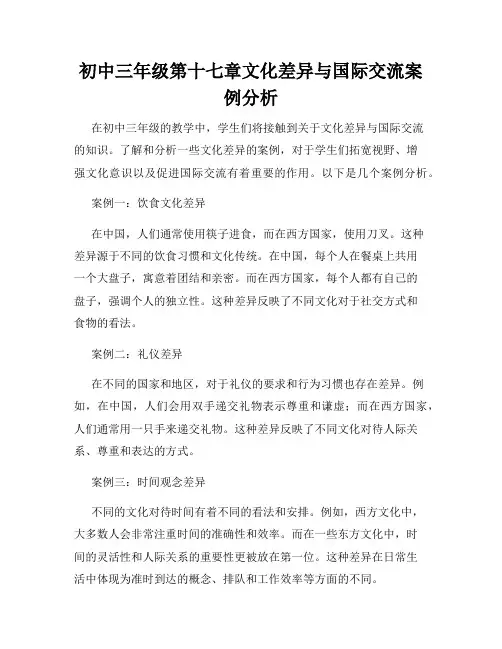
初中三年级第十七章文化差异与国际交流案例分析在初中三年级的教学中,学生们将接触到关于文化差异与国际交流的知识。
了解和分析一些文化差异的案例,对于学生们拓宽视野、增强文化意识以及促进国际交流有着重要的作用。
以下是几个案例分析。
案例一:饮食文化差异在中国,人们通常使用筷子进食,而在西方国家,使用刀叉。
这种差异源于不同的饮食习惯和文化传统。
在中国,每个人在餐桌上共用一个大盘子,寓意着团结和亲密。
而在西方国家,每个人都有自己的盘子,强调个人的独立性。
这种差异反映了不同文化对于社交方式和食物的看法。
案例二:礼仪差异在不同的国家和地区,对于礼仪的要求和行为习惯也存在差异。
例如,在中国,人们会用双手递交礼物表示尊重和谦虚;而在西方国家,人们通常用一只手来递交礼物。
这种差异反映了不同文化对待人际关系、尊重和表达的方式。
案例三:时间观念差异不同的文化对待时间有着不同的看法和安排。
例如,西方文化中,大多数人会非常注重时间的准确性和效率。
而在一些东方文化中,时间的灵活性和人际关系的重要性更被放在第一位。
这种差异在日常生活中体现为准时到达的概念、排队和工作效率等方面的不同。
案例四:语言和沟通差异不同的语言有着不同的语法、词汇和表达方式,这也影响着人们之间的沟通。
例如,英语中的“you”一词可以表示单数和复数;而在中文中,需要根据具体情况使用不同的代词。
这种差异可能导致语言障碍和误解,同时也促进了跨文化的交流和学习。
通过以上案例分析,我们可以看到不同文化之间的差异和相互影响。
在国际交流中,我们需要尊重和理解对方的文化,同时也要积极学习并传播自己的文化。
这有助于促进文化多样性的发展,加深不同文化之间的了解和友谊。
在初中教育中,学习和了解文化差异与国际交流是一个重要的内容。
通过案例分析,学生们可以从实际生活中感受到不同文化的特点和差异,并培养跨文化交流的能力。
同时,教师也应该注重培养学生的文化意识,提倡尊重、包容和理解不同的文化现象。
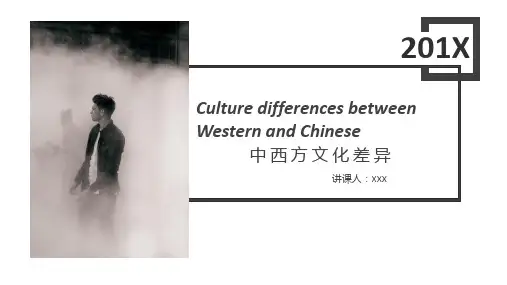
幼儿园跨文化体验:中西方文化差异教育活动案例1.介绍在当今日益全球化的社会中,不同文化之间的交流和融合变得日益重要。
幼儿园是孩子们接受教育的重要阶段,在这个阶段,如何让孩子们接触和理解不同文化,成为了一个备受关注的话题。
本文将通过介绍中西方文化差异的教育活动案例,探讨幼儿园跨文化体验的重要性和方法。
2.中西方文化差异在中西方文化之间存在着许多差异,例如在价值观念、教育观念和行为规范等方面。
在西方文化中,重视个性和自由发展,注重培养孩子独立思考和自我表达能力;而在我国文化中,重视集体和家庭观念,注重孩子的服从和成就。
这些差异也影响了幼儿园教育活动的设计和实施。
3.教育活动案例(1)双语故事会通过双语故事会,让孩子们在听取中西方故事的感受不同文化的魅力。
在故事会中,可以选择西方经典童话和我国传统故事来讲述,让孩子们比较和探究两种文化的不同之处。
(2)节日文化体验将中西方的传统节日活动引入幼儿园,让孩子们亲身参与并体验其中的文化内涵。
在西方的圣诞节期间,可以组织孩子们制作圣诞卡片、装饰圣诞树,并让他们了解圣诞老人的故事;而在我国的春节期间,可以教孩子们制作灯笼、包饺子,并讲解我国的传统习俗和传说。
(3)跨文化游戏与合作设计一些既融合中西方元素又注重合作与沟通的游戏活动,比如中西方跳绳游戏、合作搭积木等。
这样一来,不仅能锻炼孩子们的身体协调和合作能力,还可以让他们在游戏中体验和学习不同文化的乐趣。
4.总结与回顾幼儿园是培养孩子综合素质的关键时期,而跨文化体验和教育活动能够帮助孩子们开拓视野、增加见识,促进他们的跨文化交流和理解。
通过双语故事会、节日文化体验和跨文化游戏等教育活动,孩子们不仅能够在玩中学,在乐趣中感受不同文化的魅力,也能够培养跨文化交流与合作的能力。
5.个人观点与理解在我看来,幼儿园是一个非常重要的阶段,孩子们在这里接受的不仅仅是知识和技能,更重要的是文化和价值观念的塑造。
跨文化体验和教育活动应该成为幼儿园教育中的一项重要内容,以帮助孩子们增加文化认知、提高跨文化交流能力,为他们未来的成长和发展打下坚实的基础。
中西文化差异案例一、饮食文化差异。
1. 案例一:早餐的较量。
我有个中国朋友小明和一个美国朋友杰克住在一起。
一天早上,小明拿出油条、豆浆和茶叶蛋,热情地招呼杰克一起吃。
杰克一脸疑惑地看着这些食物。
他拿起油条咬了一口,皱着眉头说:“这东西怎么这么油啊,感觉像在吃油炸面团。
”然后他又喝了一口豆浆,嘟囔着:“这是什么味道,有点像没加糖的奶昔,但是又很奇怪。
”而小明呢,看着杰克的反应觉得很有趣。
杰克接着拿出他的早餐,是一大杯冰牛奶、几片全麦面包和一块黄油。
小明尝了一口面包,觉得干巴巴的,没有什么味道,冰牛奶也让他的胃有点不舒服,他说:“这面包怎么像在嚼纸一样,冰牛奶早上喝也太凉了。
”这个案例就很明显地体现了中美饮食文化在早餐上的差异。
在中国,早餐讲究热乎、有滋有味,油条豆浆是经典搭配。
而在美国,冷的牛奶、简单的面包黄油是常见的早餐选择,注重方便快捷和营养搭配。
2. 案例二:吃动物内脏。
我和一群外国朋友去吃火锅。
当我点了毛肚、鸭肠、猪肝等内脏类食物时,他们都露出了惊恐的表情。
其中一个英国朋友说:“你们怎么能吃这些东西呢?这在我们那里是不被接受的。
”我笑着说:“这些可都是美味啊,尤其是毛肚,在火锅里七上八下涮一涮,又脆又嫩。
”他们根本无法理解我们中国人对内脏类食物的喜爱。
在西方文化中,很多人认为动物内脏是不干净或者不适合食用的,而在中国,经过精心烹饪的内脏可以成为餐桌上的佳肴,像卤煮、九转大肠等都是很有名的菜肴。
二、社交文化差异。
1. 案例一:见面打招呼。
我在国外旅行的时候,遇到一个法国姑娘。
我按照中国人的习惯,很热情地问她:“你吃了吗?”她一脸茫然地看着我,回答说:“还没有,怎么了?”我才意识到这个招呼方式让她很困惑。
在法国,人们见面通常会亲吻脸颊或者简单地说“Bonjour(你好)”。
而在中国,“吃了吗”是一种很常见的打招呼用语,这体现了中国人对饮食的重视以及这种问候背后的一种亲切和关怀的态度,但在西方文化中可能会被误解为真的在询问吃饭与否的问题。
幼儿园中外文化差异教育教案案例研究引言在幼儿园教育中,教师需要关注和尊重不同文化背景的学生,以确保他们能够融入教学环境并取得良好的学习效果。
本文将通过分析中外文化差异的教育教案案例研究,探讨如何更好地满足不同文化背景学生的教育需求。
一、案例背景分析1.1 中外文化差异的影响在幼儿园教育中,中外文化差异会对学生的学习、行为和交往方式产生影响。
西方文化注重个人主义和自我表达,而东方文化则更加注重集体主义和尊重他人。
教师需要根据学生的文化背景调整教学方式和教学内容,以促进学生的全面发展。
1.2 案例描述以某幼儿园中外文化差异教育教案为例,该教案旨在通过活动和游戏,让学生了解和尊重不同的文化传统,并培养跨文化交流能力。
具体内容包括西方节日介绍、中国传统文化体验等,旨在通过实际体验增进幼儿对不同文化的理解和尊重。
二、教育教案实施与效果分析2.1 实施过程教案实施过程中,教师结合幼儿的实际情况,设计了丰富多彩的活动,如模拟西方圣诞节礼物交换、制作中国结等。
通过这些活动,幼儿在体验中获得了对不同文化的直观认识,并通过参与感受到了跨文化交流的乐趣。
2.2 效果评估根据教育教案实施后的效果评估发现,幼儿对于西方文化节日有了更深的理解,同时也对中国传统文化产生了浓厚的兴趣。
他们开始尊重并理解不同文化背景下的行为和习惯,形成了包容和开放的心态。
三、对教育教案的思考与展望3.1 思考总结通过本案例研究,我们发现教育教案能够有效地引导幼儿理解和尊重不同文化,促进跨文化交流。
教师在设计教案时需要深入了解学生的文化背景,因地制宜地设置教学内容和活动,从而实现教学目标。
3.2 展望与建议在今后的教育教案设计中,可以进一步加强跨文化交流的内容,并结合实际情况,引入更多有趣的活动,以激发幼儿的学习兴趣。
教师需要通过不断的学习和反思,提升自身的跨文化教育能力,为幼儿提供更具有包容性和多元化的教育环境。
结语中外文化差异教育教案的研究和实践为我们提供了借鉴和启示。
初中政治:结合案例探讨世界文化差异教案随着我国对外开放的不断深入,各种国际交流活动频繁发生,越来越多的中国人踏上了世界文化之旅。
然而,对世界各国文化的认识是否深刻并成熟,却是一个有待探讨的问题。
因此,帮助学生深刻了解世界各国文化差异,有助于拓宽他们视野,增强他们民族自信心。
本文通过结合案例,探讨如何编写一份世界文化差异教案。
一、案例介绍在国际学校的一堂人文课中,教师邀请了以色列籍学生David来做客,和学生们分享以色列的历史、文化和宗教。
David首先向全体学生介绍了以色列的宗教——犹太教,他告诉大家,在国际舞台上,犹太教人数虽然只占全球人口的0.2%,却在各个领域产生了巨大的影响力,例如犹太人在科技、商业、金融、娱乐界等各个领域都拥有很高的素质和才华。
David接着分享了犹太教的主要信仰:只信一位上帝,敬畏上帝,强调生命的尊贵和圣洁,认为所有的人都应该相互关爱、互相扶持。
David还与同学们一起唱起了犹太教的圣歌。
接着,David又向全体同学介绍了以色列悠久的历史文化,从远古时代起,以色列人就是一个坚强、勇敢、富有创造力和探索精神的民族。
David通过详细的介绍,让同学们了解了以色列文化的魅力所在,让学生深刻认识到,每一个国家都有自己的文化底蕴,都值得尊重和借鉴。
二、教案探讨以上述案例为基础,我们来探讨如何编写一份世界文化差异教案。
一个好的教案,必须包含以下几个方面:1、目标要清晰教师的首要任务是制定学习目标,目标要清晰而明确。
在这样的教学情境下,可以让学生了解不同国家、民族的文化差异,尊重和包容各种文化,增强自己的跨文化沟通能力和意识。
2、选材要恰当选材要贴近学生的生活,且内容要丰富多彩。
可以结合自己或家人的国际旅游经验,选取具有代表性的文化,如美国的“万圣节”、墨西哥的“亡灵节”、日本的“樱花节”,我们的国庆节等等,各个国家,都有属于自己的独特文化。
3、方法要多样在孩子们小学、初中的时期,一切的学习方式应该注重多样化。
Unit 1 Language and Culture in CommunicationTheory Communication is something we do every day. It takes place so naturally that we simply fail to notice it until it hiccups or breaks down. Though it is commonplace, it is no exaggeration to say that communication is life and life is communication.1.When you join a social gathering, you must be aware of rules and procedures that govern the way things are going to proceed. There is a technical term for such rules and procedures—schema.2. Face and politeness are two other areas which are extremely value—sensitive. One of the distinctive features of Chinese politeness is self—denigration and other—elevation.Case 1:Litz is a professor of cross—cultural communication in a university in Finland. She invited her Chinese students home for an evening party.The schema from Litz’s point of view includes the following:1. Giving invitation: by phone / by mail2. Prepare everything before the arrival of guests3. Receiving guests: open the door / express welcome / take their overcoats / introduce guests / offer them drinks / make them comfortable4. Serving food: set the table / soup first / main course / desert5. Post dinner activities: chat / play music / offer more drinks6. Seeing guests off: thank them for coming / good nightLitz’s evening party was not very successful, because she was upset by one of her guests. Here was the initial conversation between Litz and Lin:Litz: (opens the door) Oh, Lin, how nice you could come!Lin: It’s not difficult to find your house. Litz: Come on in.Lin: (comes in)Litz: Can I take your coat?Lin: No, thanks.Litz: Ok, this way please.Lin: (take off her coat and hangs it) Analysis: Litz was hurt because Lin did not let her hang her coat. Litz’s offering to hang Lin’s coat is one of Litz’s ways (it’s on Litz’s schema). On Lin’s side, she thought that Litz was her supervisor and that it was inappropriate to let her supervisor hang her coat. Here we have aninstance of one action attached with different cultural values.Case 2:Finding an Interested BuyerGeorage Hall was in Beijing attending a trade fair and looking for an opportunity to do business in China. He had been very successful in his business dealings in the U S and prided himself on his ability “to get things moving.” His first day was going well .He looked around at the displays of sporting equipment to get some idea of whom he might approach. He was sure that his products, tennis rackets with an unusual new design, would arouse some interests. On the second day he approached the company which he felt would be most responsive to his products. He introduced himself to the general, a Mr. Li. Since he had read that Chinese find getting down to businessimmediately too abrupt and rude, he began a casual conversation, eventually leading up to the topic of his products and suggesting how Mr. Li’s company might benefit from using them. George then suggested that he could arrange to get together with Mr. Li and provide more specifics and documentation on his products.Mr. Li responded in fairly good English,” That would be interesting.”Knowing that he had only a few days left in Beijing, George wanted to nail down a time,” When can we meet?” asked George.“Ah.This week is very busy,” replied Mr. Li.“It sure is,” said George,” How about 10 o’clock? Meet you here.”“Tomorrow at 10 o’clock?” asked Mr. Li thoughtfully.“Right,” said George, “I’llsee you then?”“Hmm, yes; why don’t you come by tomorrow,” was the reply.“OK,” responded George,” It was nice meeting you.”The next day at 10 o’clock he approached Mr. Li’s company’s exhibit only to find that Mr. Li had some important business and was not able to meet with George. He called back later in the day and was told that Mr. Li was not available.Analysis: 英美人士做事情讲究守时。
中西文化差异情景案例分析Culture Difference Case StudyUnit 1 Language and Culture in CommunicationTheoryCommunication is something we do every day. It takes place so naturally that we simply fail to notice it until it hiccups or breaks down. Though it is commonplace, it is no exaggeration to say that communication is life and life is communication.1.When you join a social gathering, you must be aware of rules and procedures that govern the way things are going to proceed. There is a technical term for such rules and procedures—schema.2. Face and politeness are two other areas which are extremely value—sensitive. One of the distinctive features of Chinese politeness is self—denigration and other—elevation.Case 1Litz is a professor of cross—cultural communication in a university in Finland. She invited her Chinese students home for an evening party.The schema from Litz’s point of view includes the following:1. Giving invitation: by phone / by mail2. Prepare everything before the arrival of guests3. Receiving guests: open the door / express welcome / take their overcoats / introduce guests / offer them drinks / make them comfortable4. Serving food: set the table / soup first / main course / desert5. Post dinner activities: chat / play music / offer more drinks6. Seeing guests off: thank them for coming / good nightLitz’s evening party was not very successful, because she was upset by one of her guests. Here was the initial conversation between Litz and Lin:Litz: (opens the door) Oh, Lin, how nice you could come!Lin: It’s not difficult to find your house.Litz: Come on in.Lin: (comes in)Litz: Can I take your coat?Lin: No, thanks.Litz: Ok, this way please.Lin: (take off her coat and hangs it)Analysis: Litz was hurt because Lin did not let her h ang her coat. Litz’s offering to hang Lin’s coat is one of Litz’s ways (it’s on Litz’s schema). On Lin’s side, she thought that Litz was her supervisor and that it was inappropriate to let her supervisor hang her coat. Here we have an instance of one action attached with different cultural values.Case 2Finding an Interested BuyerGeorage Hall was in Beijing attending a trade fair and looking for an opportunity to do business in China. He had been very successful in his business dealings in the US and prided himself on his ability “to get things moving.” His first day was going well .He looked around at the displays of sporting equipment to get some idea of whom he might approach. He was sure that his products, tennis rackets with an unusual new design, would arouse some interests. On the second day he approached the company which he felt would be most responsive to his products. He introduced himself to the general, a Mr. Li. Since he had read that Chinese find getting down to business immediately too abrupt and rude, he began a casual conversation, eventually leading up to the topic of his products and suggesting how Mr. Li’s company might benefit from using them. George then suggested that he could arrange to get together with Mr. Li and provide more specifics and documentation on his products.Mr. Li responded in fairly good English,” That would be interesting.”Knowing that he had only a few days left in Beijing, George wanted to nail down a time,” When can we meet?” asked George.“Ah. This week is very busy,” replied Mr. Li.“It sure is,” said George,” How about 10 o’clock? Meet you here.”“Tomorrow at 10 o’clock?” asked Mr. Li thoughtfully.“Right,” said George, “I’ll see you then?”“Hmm, yes; why don’t you come by tomorrow,” was the reply.“OK,” responded George,” It was nice meeting you.”The next day at 10 o’clock he approached Mr. Li’s company’s exhibit only to find that Mr. Li had some important business and was not able to meet with George. He called back later in the day and was told that Mr. Li was not available.Analysis:英美人士做事情讲究守时。
而中国人不太重视这方面。
本案列中,李先生不仅没有准时接见预约的客户,甚至放了他“鸽子”。
Case 3Professor Liang has written a book on Chinese culture in Chinese. His book is put on display in Beijing International Book Fair’ 96. Professor Liang would like to have his book translated into English and submitted to Thompson Publishers. Professor Liang has asked Li Yan, whom he meets regularly in the English Corner, to help him to talk to Peter Allright, a Thompson representative.Prof. Liang:奥莱特先生,这是鄙人的拙作。
Li Tan: Mr. Allright, this a clumsy book written by your humble servant.Mr Allright: No, no, no, you're not my humble servant. We do not publish books in Chinese. Li Yan (to Professor Liang): 不,不,不,你不是我的仆人,我们不出中文书。